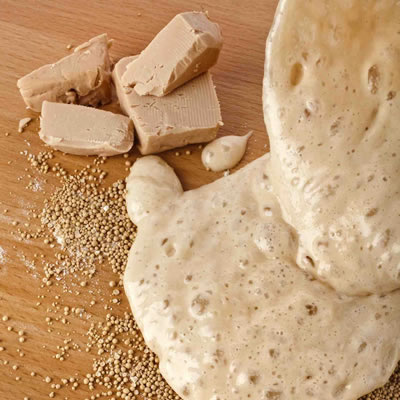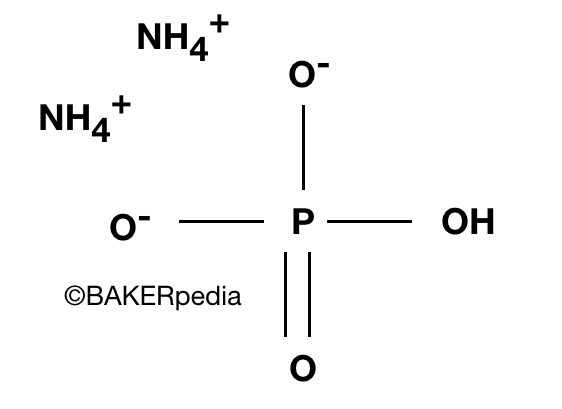
Diammonium Hydrogen Phosphate (DAP)
What is DAP?
DAP is a water-soluble inorganic phosphate salt, mostly used in the baking industry as a synergistic ingredient in breadmaking. Incorporation of of the salt is helpful for:
- Providing phosphorus and nitrogen, vital nutrients for yeast cells
- Enhancing growth of yeast cells
- Helping yeasts to absorb other micronutrients
- Speeding up fermentation reactions (enhancing metabolic production, e.g., carbon dioxide and alcohol)
- Controlling pH of sponge doughs, due to its buffer nature
- Strengthening and conditioning dough mixtures
Origin
The DAP compound is the product of the reaction between ammonia (a base) and phosphoric acid (a triprotic acid acting as a proton donor to ammonia) at a pH above 5.8:1
NH3 + H3PO4 → (NH4)2HPO4

A Diammonium Phosphate molecule.
Function
In the first stages of dough fermentation, it is essential to provide micronutrients for yeast cells. The goal is to enhance the growth of yeast cells (biomass) rather than pursue the rapid production of primary metabolic products (e.g., carbon dioxide and alcohol).
Certain trace elements like phosphorus, magnesium, and others are required by the yeast cells to assure optimal growth during fermentation because they act as cofactors in many enzymatic reactions and participate in all phases of of the metabolism of the yeasts.2
Another key factor in yeast fermentations is nitrogen, that is, the amino acid level in the dough liquid phase. Here, the level of assimilable nitrogen can be increased by the addition of DAP.3
Nutrition
Due to its inorganic nature, DAP has no nutritive value for humans. The acceptable daily intake for humans of phosphoric acid (in the form of DAP) is up to 70 mg/kg body weight.4
Application
The optimal level of DAP as a nutritive ingredient for yeasts can be in the range of 10–20 ppm. Specific amounts can vary depending on the yeast strain used in each bakery, process requirements, and the formulations set.4
The following are a few conditions to take into account when using DAP:
- It is usually sold as a white particulate “crystal like” material, with a purity higher than 99%.1
- It should be stored along with non-allergenic powdered ingredients.
- It usually sells in a 12.5 kg bag.
- As a micro ingredient, it can be incorporated into the formulation by premixing with process water.
FDA regulation
According to FDA 21 CFR Part 184 (Direct Food Substances Affirmed as Generally Recognized as Safe), DAP is considered GRAS by the FDA for miscellaneous and general-purpose direct usage in food products, with no limitation other than that imposed by Good Manufacturing Practices.5
References
- SIGMA-ALDRICH. “Ammonium Phosphate Dibasic – Product Specification.”, https://www.sigmaaldrich.com/catalog/substance/ammoniumphosphatedibasic13206778328011?lang=en®ion=CO&attrlist=Solubility. Accessed 9 March 2018.
- Bonjean, B., and Guillaume, L.-D. “Yeasts in Bread and Baking Products.” Yeasts in Food: Beneficial and Detrimental Aspects, Woodhead Publishing Ltd, and CRC Press LLC, 2003, pp. 289–303.
- Bamforth, C.W. Food, Fermentation and Micro-organisms, Blackwell Publishing Ltd, 2005, pp. 99, 115.
- Doores, S. “Acidulants.” Food Additives Data Book, 2nd ed., Blackwell Publishing Ltd., 2011, pp. 36–46.
- U.S. Food and Drug Administration. “21 CFR 184 – Direct Food Substances Affirmed as Generally Recognized as Safe.” 1 April 2017, https://www.accessdata.fda.gov/scripts/cdrh/cfdocs/cfcfr/CFRSearch.cfm?CFRPart=184.

